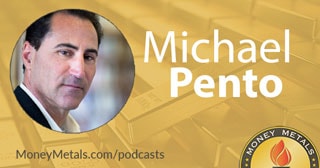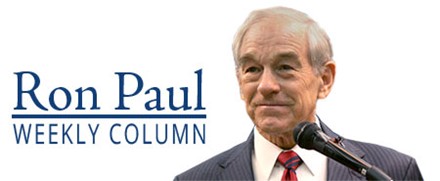Fed Actions Are WAY More Impactful on Gold/Silver Than Politics
by Mike Gleason, Money Metals:

Coming up Michael Pento of Pento Portfolio Strategies joins me for another top-flight interview as we discuss some major stresses in the financial system that are going to result in some serious issues in the economy. He also talks about the trade summit happening next month and what it will likely mean for precious metals if a deal is struck between the U.S. and China, or if an agreement is not reached. So be sure to stick around for my conversation with Michael Pento, coming up after this week’s market update.
Precious metals markets are trading in wide ranges as they struggle to hold on to gains posted earlier in the week.
As of this Friday recording, the metals are taking it on the chin here today with gold now looking at a weekly decline of 1.6% to trade at $1,494 an ounce. Silver is down 3.0% for the week to come in at $17.49 per ounce. Platinum is moving lower this week by 1.4% and currently fetches $937 an ounce. And finally, palladium is now commanding $1,692 per ounce after rising another 2.7% this week.
Hard assets in general are facing a headwind from a rising U.S. dollar versus foreign currencies. Precious metals, however, managed to gain in dollar terms and in terms of all major fiat currencies this summer. We’ll see if they can regain some momentum this fall.
In the meantime, investors are trying to balance the prospects for a Trump trade deal with China against the risks of the President being impeached.
On Tuesday, Democrat leader Nancy Pelosi announced that Congress would begin a formal impeachment inquiry against President Donald J. Trump. Partisan camps on both sides have planted their stakes in the ground, but investors want to know how the unfolding political drama will impact their wealth.
Will these impeachment proceedings bring down a presidency and doom the “Make America Great Again” policy agenda? Or will they devolve into a political sideshow that markets largely ignore?
The most likely outcome appears to be that impeachment will fail. Even if President Trump is impeached by the Democrat-controlled House, the odds of him being forced out of office by a two-thirds vote in the Republican-controlled Senate are slim. It would be difficult to imagine Trump resigning from office under any circumstance.
A failed impeachment effort might even help President Trump politically. It would rally his supporters to his side and could lead moderate voters to view Democrats as hyper-partisans who are singularly driven by anti-Trump animus.
As for how an impeachment effort might impact markets, history suggests it probably won’t change any major trends already in place. Neither the resignation of Richard Nixon nor the impeachment and acquittal of Bill Clinton caused the stock market to crash.
Precious metals markets didn’t move much around these momentous political events, either.
The House of Representatives initiated articles of impeachment against President Clinton on December 19, 1998. On February 12, 1999, the U.S. Senate voted to acquit Clinton and leave him in office.
Around that period, gold prices were in a long bottoming out process after having been in a bear market since peaking in January 1980. From the time Clinton was impeached to his acquittal, gold meandered around just under $300 an ounce. Interestingly, silver popped from $4.95 to $5.65 and the S&P 500 also made slight gains.
President Nixon resigned on August 8, 1974 with gold trading at $152. Gold began the year at $117 and finished at $195 per ounce. Nixon’s resignation occurred within a major year-long rally and doesn’t seem to have altered its trajectory, though it might have amplified the upside a bit.
Overall, the Watergate scandal that took down Nixon didn’t leave a lasting impact on markets. The much bigger legacy Nixon left is what has happened to the dollar since he ended its redeemability in gold. The consequences of the dollar’s lost status as a gold-backed currency are still playing out.
Under the post-World War II Bretton Woods system, U.S. dollars had been redeemable in gold by foreign countries. But Nixon feared a run on U.S. gold reserves and in 1971 announced to the public that the dollar would no longer be convertible into gold.
Richard Nixon: We must protect the position of the American dollar as a pillar of monetary stability around the world.
Accordingly, I have directed the Secretary of the Treasury to take the action necessary to defend the dollar against the speculators.
I have directed Secretary Connally to suspend temporarily the convertibility of the dollar into gold or other reserve assets.
Let me lay to rest, the bugaboo of what is called devaluation. If you want to buy a foreign car or take a trip abroad, market conditions may cause your dollar to buy slightly less.
But if you are among the overwhelming majority of Americans who buy American made products in America, your dollar will be worth just as much tomorrow as it is today.
Richard Nixon was no George Washington, and “Tricky Dick” didn’t always tell the truth. His claim that the dollar would be worth just as much tomorrow as today turned out to be quite a whopper. The fiat dollar’s purchasing power fell rapidly during the 1970s – not just against foreign currencies, but against real things. Commodity and precious metals prices surged, culminating with gold spiking to $850.
According to the Bureau of Labor Statistics’ own CPI Inflation Calculator, a dollar in August 1971, just before Nixon de-linked it from gold, is worth 16 cents today. That’s an 84% devaluation.
The lesson for investors is that trends in monetary policy matter a whole lot more for their wealth than momentary political headlines. The monetary policies now being implemented by the Federal Reserve are intended to gradually devalue the dollar.
In recent weeks, the Fed has inflated more aggressively – dropping its benchmark interest rate, letting its balance sheet expand, and pumping hundreds of billions of dollars into the troubled overnight lending market for banks.
On Wednesday, the Federal Reserve Bank of New York announced that it would increase its maximum daily repo market operations from $75 billion to a $100 billion. Fed officials are also considering a new standing repo facility to provide liquidity on a more permanent basis.
They insist it’s not Quantitative Easing per se. But regardless of what they call it, they are inflating the currency supply in their biggest intervention into financial markets since 2008. There will be unintended consequences – and they could visit themselves upon investors in the weeks and months ahead.
Well now for more on the effects of all of this liquidity being pumped into the repo market, and a whole lot more, let’s get right to this week’s exclusive interview.
Loading...



